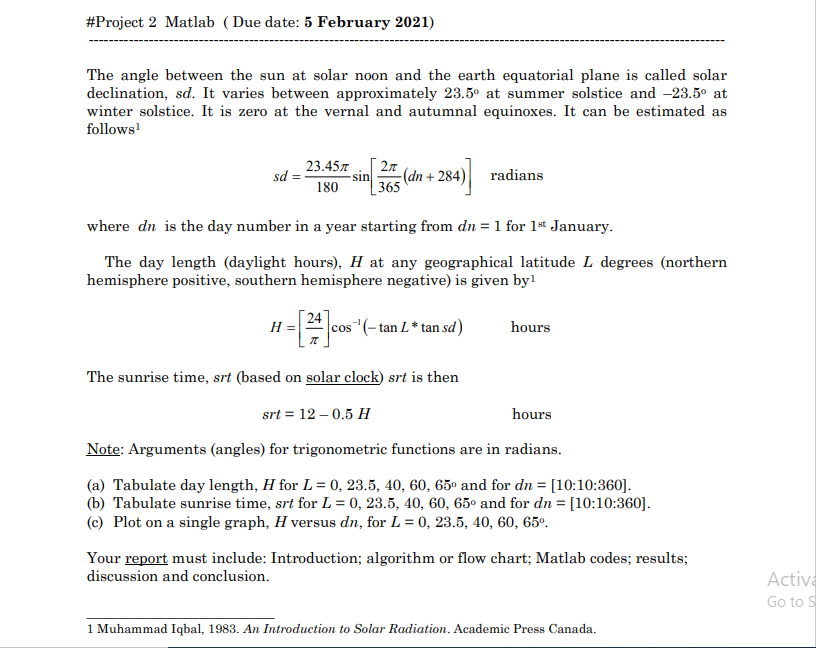Answered step by step
Verified Expert Solution
Question
1 Approved Answer
### i just need the Matlab codes and results. #Project 2 Matlab (Due date: 5 February 2021) The angle between the sun at solar noon

### i just need the Matlab codes and results.
#Project 2 Matlab (Due date: 5 February 2021) The angle between the sun at solar noon and the earth equatorial plane is called solar declination, sd. It varies between approximately 23.5 at summer solstice and -23.5 at winter solstice. It is zero at the vernal and autumnal equinoxes. It can be estimated as follows: sd 23.451 27 sin (dn + 284) 180 365 radians where dn is the day number in a year starting from dn = 1 for 1st January. The day length (daylight hours), H at any geographical latitude L degrees (northern hemisphere positive, southern hemisphere negative) is given byl H= 24 cos'(-tan L* tan sd) hours The sunrise time, srt (based on solar clock) srt is then srt = 12 -0.5 H hours Note: Arguments (angles) for trigonometric functions are in radians. (a) Tabulate day length, H for L = 0, 23.5, 40, 60, 65 and for dn = [10:10:360). (b) Tabulate sunrise time, srt for L = 0, 23.5, 40, 60, 65 and for dn = [10:10:360). (C) Plot on a single graph, H versus dn, for L = 0, 23.5, 40, 60, 65. Your report must include: Introduction; algorithm or flow chart; Matlab codes, results; discussion and conclusion. Active Go to s 1 Muhammad Iqbal, 1983. An Introduction to Solar Radiation. Academic Press Canada. #Project 2 Matlab (Due date: 5 February 2021) The angle between the sun at solar noon and the earth equatorial plane is called solar declination, sd. It varies between approximately 23.5 at summer solstice and -23.5 at winter solstice. It is zero at the vernal and autumnal equinoxes. It can be estimated as follows: sd 23.451 27 sin (dn + 284) 180 365 radians where dn is the day number in a year starting from dn = 1 for 1st January. The day length (daylight hours), H at any geographical latitude L degrees (northern hemisphere positive, southern hemisphere negative) is given byl H= 24 cos'(-tan L* tan sd) hours The sunrise time, srt (based on solar clock) srt is then srt = 12 -0.5 H hours Note: Arguments (angles) for trigonometric functions are in radians. (a) Tabulate day length, H for L = 0, 23.5, 40, 60, 65 and for dn = [10:10:360). (b) Tabulate sunrise time, srt for L = 0, 23.5, 40, 60, 65 and for dn = [10:10:360). (C) Plot on a single graph, H versus dn, for L = 0, 23.5, 40, 60, 65. Your report must include: Introduction; algorithm or flow chart; Matlab codes, results; discussion and conclusion. Active Go to s 1 Muhammad Iqbal, 1983. An Introduction to Solar Radiation. Academic Press CanadaStep by Step Solution
There are 3 Steps involved in it
Step: 1

Get Instant Access to Expert-Tailored Solutions
See step-by-step solutions with expert insights and AI powered tools for academic success
Step: 2

Step: 3

Ace Your Homework with AI
Get the answers you need in no time with our AI-driven, step-by-step assistance
Get Started


